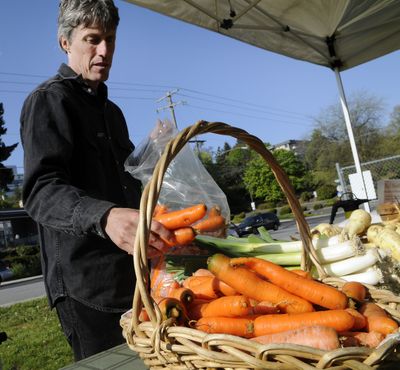Be smart – and eat your veggies for less

NEW YORK – We hear it time and time again: “Eat your veggies!” From the grocery aisle to the farmers market, vegetables are plentiful. But it is all too easy to wind up with wan, dried-out carrots from the supermarket or overpriced broccoli from a farm stand.
Here’s how to get the best-tasting vegetables at the right price:
Know your season
Asparagus can be slender and expensive during the winter, but come spring it is plentiful, thick and far cheaper.
Why is that? When a vegetable isn’t in season locally, it may be coming from hundreds or thousands of miles away, trucked or flown in. That adds significant transportation and fuel expense to the cost of vegetables – which aren’t as fresh as in-season produce. So buying in-season is cheaper, and you get fresher, tastier vegetables.
Check out online guides to make sure you’re getting the most for your money. There’s a handy guide by the Centers for Disease Control and Prevention with details of when fruits and vegetables are in season and what they should look like if they’re ripe. Broccoli is in season anytime but summer months, for example, while cucumbers are peaking May through August. http://bit.ly/cQL1Tp
Opt for a CSA box
If you like a lot of different types of vegetables, try a box from a CSA, which stands for community supported agriculture. These programs are growing in popularity.
If you join a CSA program, you’ll pay around several hundred dollars up front and then get a box of fresh vegetables from one or two farms each week, usually June through November. It’s expensive to pay all that money up front, but if you eat a lot of vegetables, it generally adds up to less than you would pay if you bought vegetables elsewhere.
However, you don’t have much of a choice in what you’re getting. So if you’re picky about what vegetables you eat, or you just don’t eat that many vegetables, consider going to a local greenmarket instead.
“If you won’t eat beets and you have no idea what to do with a celery root, you’ll end up paying more for the vegetables you do use,” says Jack Bishop, editorial director of public television’s “America’s Test Kitchen.”
Visit a farmers market
If you want more choices, hit a local farmers market, where farmers set up tables laden with their bounty through most spring, summer and fall months. There are several ways to get deals on veggies at the markets.
“Be flexible,” Bishop advises. “You’re not only responding to what looks best at the market, you should also be willing to pounce on something priced nicely.” If you come in looking for asparagus but it is pricey and looks wilted, buy the cheaper leeks and onions nearby.
Many people get to farmers markets early for the best selection, but Bishop offers another strategy: go late and buy more, and be willing to haggle.
“Farmers, especially later in the day, have a real incentive not to want to bring back whatever it is they brought to the market,” Bishop says. “Especially if you’re willing to buy an extra pound of two, try to bargain. The worst a farmer can do is say no.”
Cheryl Huber, assistant director for Grow NYC, which runs 53 greenmarkets around New York City, says the key at markets is to shop around. To make things easier, find a market manager and ask for advice.
“It’s a great way to find out who has a good deal, what’s new and what’s in season,” she says.
Join a food co-op
Food co-ops are an alternative to traditional grocery stores, where your elbow grease cuts down on the price of farm-fresh veggies. Rules and requirements for co-ops vary, but traditionally, food co-ops are created and staffed by members only. That keeps overhead costs down, so co-ops can offer high quality vegetables at not-so-steep prices.
The tradeoff is you usually have to work at the co-op for several hours a month and be involved in decisions about how the co-op is run. Some co-ops allow non-members to buy produce but usually charge them higher prices.
Check this online directory to find a co-op in your area: www.cooperativegrocer. coop/coops.
Don’t neglect frozen
They might not have the cachet or look as pretty as the fresh variety, but they’re cheaper, quicker to prepare and they can actually keep their nutrients longer than fresh.
But make sure you pick the right frozen vegetables to buy – Bishop says two favorites of “America’s Test Kitchen” are peas and spinach.
“With the exception of peas that are picked the same day they’re bought, frozen peas are usually sweeter than fresh peas at a regular supermarket,” he said.
Frozen spinach can be a good buy in part because it cuts down on the effort of cleaning and chopping, particularly since spinach cooks down so much. “It cuts out a fair amount of work,” he said.
Frozen vegetables are usually better used in combo dishes like soup, stew or risotto than on their own, he adds.